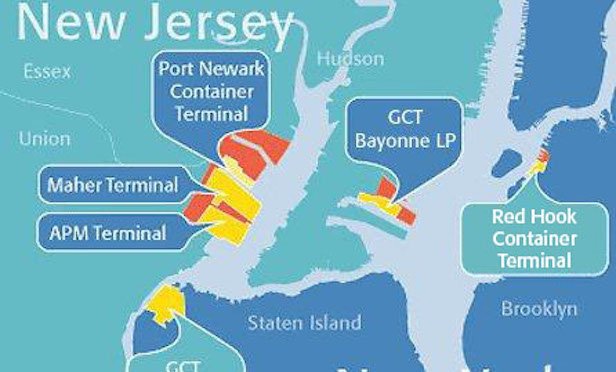 During 2019, the Port of New York and New Jersey handled 7,471,131 TEUs (20-foot equivalent units), breaking the previous annual record of 7,179,788 TEUs in 2018.
During 2019, the Port of New York and New Jersey handled 7,471,131 TEUs (20-foot equivalent units), breaking the previous annual record of 7,179,788 TEUs in 2018.
NEW YORK CITY—2019 was a record year for the Port Authority of New York and New Jersey for its port cargo, as well as passenger air volume.
The Port Authority reports its 2019 passenger and cargo volume across its facilities established new records at the airports, seaport, PATH system, Goethals Bridge and Staten Island Bridges.
The Port Authority points to the record volumes as validation of the agency's historic $37 billion 10-year Capital Plan to rebuild and significantly upgrade its legacy facilities that were built decades ago to handle far smaller volumes of people and cargo.
"Our legacy facilities were built to handle passenger and cargo volumes from a bygone era and simply cannot continue to support the record level of activity they must now handle on a daily basis," said Port Authority executive director Rick Cotton. "That's why we are firmly committed to rebuild our airports and build new rail mass transit links to them, rebuild the nearly 70-year-old Port Authority Bus Terminal, modernize the PATH system and upgrade our port to enable all facilities to handle continued growth."
During 2019, the Port of New York and New Jersey handled 7,471,131 TEUs (20-foot equivalent units), breaking the previous annual record of 7,179,788 TEUs in 2018. The cargo growth was bolstered by a 2.6% increase in imported goods including clothing, furniture, electronics and other everyday products over the previous record for imports set in 2018.
During the year, the port handled 5,231,418 loaded TEUs, surpassing the loaded imports handled by the Port of Long Beach, CA elevating the port to No. 2 in the nation for the first time in two decades.
The port also set a new all-time record for cargo handled by rail, moving 664,987 containers by rail, up 3% over the previous record set in 2018.
To accommodate the ongoing record cargo growth, the Port Authority last June announced the completion of the ExpressRail Port Jersey facility, the final piece of the Port of New York and New Jersey's intermodal rail network spanning facilities in Elizabeth, Newark and Staten Island. The completion of the upgraded rail network provides the port with future capacity to handle up to 1.5 million rail lifts annually, enabling it to compete for more cargo destined to the middle of the country, the Port Authority states.
The opening of the new facility allows the port to advance its strategic goal to handle more than 900,000 rail lifts a year during the next five years, the equivalent of more than 1.5 million fewer truck trips traveling through local roads, which will greatly reduce congestion and enhance air quality.
In terms of air passenger volume, the Port Authority handled a record 140.5 million passengers at its four commercial airports—John F. Kennedy International, Newark Liberty International, LaGuardia and New York Stewart International airports—in 2019, which was an increase of 1.6% over the previous record of 138.2 million passengers handled in 2018.
The largest percentage increase was reported at LaGuardia Airport. Despite major construction underway with temporary roadways across much of the airport, LaGuardia handled 31 million passengers in 2019, a 3.3% increase over the previous record passenger volume handled in 2018. JFK Airport reported a 1.5% increase in passengers, including new records for both domestic and international travelers. Last year, Newark Liberty serviced more than 46 million passengers, a 1% increase in air passengers over the previous 2018 record volume.
Rail mass transit use at John F. Kennedy International and Newark Liberty International continued its record growth. The agency's two AirTrain systems set annual passenger records in 2019. AirTrain JFK handled nearly 21 million passengers in 2019, surpassing the previous annual record set in 2018. AirTrain Newark handled more than 11 million passengers in 2019, surpassing the previous annual record handled in 2018.
The average PATH daily weekday ridership hit 284,380 in 2019, the highest weekday ridership ever recorded on the rail system. The highest one-day ridership recorded in 2019 was 311,317, which occurred on July 24.
During 2019, PATH handled 82.22 million passengers, the second highest annual ridership on record. The 2019 passenger levels would have been a new record had it not been for the anomaly of 1.2 million NJ Transit ticket holders who were cross honored in 2017, including 933,000 who were cross honored during the summertime track shutdowns to accommodate emergency repairs at New York's Penn Station.
At the Port Authority's crossings, the Goethals Bridge established a new annual record for traffic in 2019, reporting 17.7 million eastbound trips, a 6.6% increase over the previous record set in 2018.
The three Staten Island Bridges—the Goethals and Bayonne bridges and the Outerbridge Crossing—collectively set a new traffic record in 2019, handling 36.1 million eastbound vehicles, a 4% increase over the previous annual record set in 2018.
During 2019, all six of the Port Authority's crossings, including the Lincoln and Holland tunnels, the George Washington Bridge and Staten Island Bridges, accommodated 122.2 million eastbound vehicles, the highest annual volume reported in 10 years.
© Touchpoint Markets, All Rights Reserved. Request academic re-use from www.copyright.com. All other uses, submit a request to [email protected]. For more inforrmation visit Asset & Logo Licensing.







